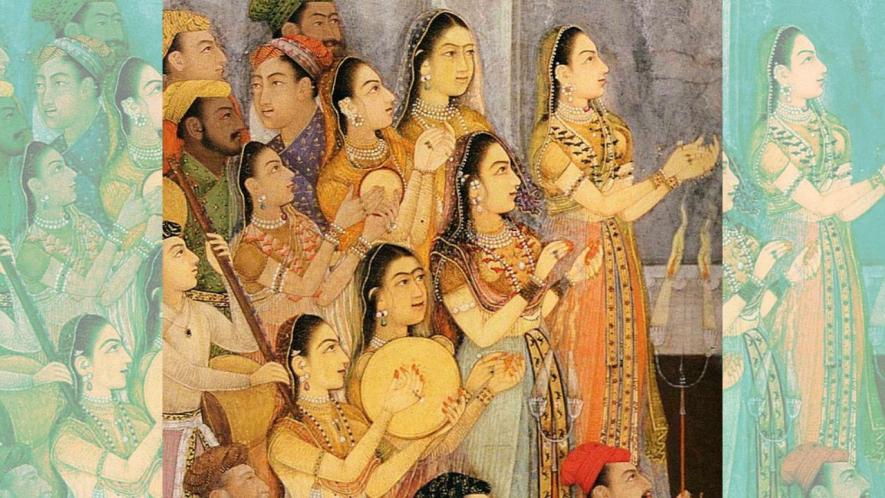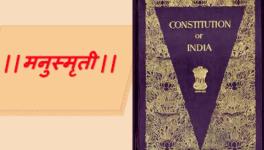Did Muslim Invasions Subjugate Hindu Women?

Image courtesy: Wikimedia Commons
The rise of the Rashtriya Swayamsevak Sangh (RSS) and its opposition to demands for caste and gender equality raised during the freedom movement went hand in hand. When India was a ‘nation in the making’, it sought to grant equality to all, which undermined the older feudal hierarchies. While Indian nationhood sought equality for all, irrespective of caste, class and gender, those who upheld the traditional order asserted themselves, too. Muslim and Hindu conservatives often couched their backwardness in the language of religion.
The Hindu-nationalist RSS created a narrative about a golden past, an age when Manu and his word were law. It also claimed that “Hindu values” meant equal status for all castes, and women had a respectable position in Hindu society. They still claim that Muslim invaders and plunderers caused a decline in these glorious values and that evil invaders cost Hindu women their prominent place in society. They even blame the cruel practice of Sati on Muslim invasions. Such ideas and claims form the core of Hindu nationalist “myth creation” about why Hindu women were restrained.
The RSS sahkaryavah, or general secretary, Krishna Gopal, repeated all such claims on 4 September when he addressed a gathering on women’s empowerment organised by an outfit called Naari Shakti Sangam. He said, “Prior to the 12th century, women were reasonably free to a great extent, but in the middle ages [India’s medieval era], a very difficult time came. The entire country was struggling with subjugation. Women were in danger. Lakhs of women were kidnapped and sold in international markets. [Ahmed Shah’ Abdali, [Mohammed] Ghori and [Mahmood of] Ghazni took women from here and sold them. It was an era of great humiliation. So, to protect our women, our society put multiple restrictions on them.”
Gopal would have his listeners not just believe his justification to repress women but also that the plunder of wealth of rival kingdoms and enslavement of the conquered were restricted to Muslim invaders. Both, however, run through kingdoms and history. The Chola kings brought innumerable slaves from Sri Lanka. Chhatrapati Shivaji Maharaj’s army plundered Kalyan, and Kalyan’s governor’s Muslim daughter-in-law was taken captive.
The restrictions on Hindu women that Gopal refers to prevailed long before any Muslim kings set foot in South Asia—including Sati, the immolation of a widow on her husband’s funeral pyre.
Women were deprived of property and education due to the social norms prevailing in early India. In the Mahabharata, there are accounts of Pandu’s wife Madri and Lord Krishna’s father Vasudev’s four wives burning themselves to death after their husbands died.
The subordination of women was due to patriarchy, influenced by sentiments such as clan superiority, and both factors had a crucial role in Sati. As per the historian Romila Thapar, the significant factors in the rise of Sati were the subordination of women in patriarchal society, the changing “systems of kinship”, and the desire to exert “control over female sexuality”. According to most historians of repute, Sati originated within the Kshatriya aristocracy and remained limited mainly to the so-called warrior classes among Hindus.
The decline of trade and commerce in the post-Gupta period in Indian history is among the critical reasons for the decline in the status of women. They were prohibited from education; child marriage increasingly became the norm; widow remarriage was prohibited; occurrences of the dreadful practice of Sati grew, too. Before this period, Sati was an occasional phenomenon.
How does RSS deal with the issue? An exclusively male organisation, it promoted the Rashtra Sevika Samiti as a subordinate outfit. Its very name reflects the Hindu nationalist outlook on gender, for the word swayam (being, self) is missing from its name, and the word sevika—service—is included instead.
The Rashtra Sevika Samiti has been preaching to its women followers total support of the subordinate position of women. Vijaya Raje Scindia, vice-president of the Bharatiya Janata Party, the political offshoot of the RSS, took out a morcha to Parliament to support Sati in the aftermath of the Roopkawar sati case. That was when Parliament was discussing a new law to curb this practice. Scindia believed committing Sati was a “glorious” tradition and the right of Hindu women. In April 1994, Mridula Sinha, a top leader of the Samiti, who later became the Governor of Goa, advised Hindu women in an interview with Savvy magazine to “adjust” if her husband beats her—for she could have “provoked” the assault. She also defended dowry—“my father bought me a husband in just Rs 5,000”—and said women must not work outside the home unless it is a dire necessity.
We also recall former RSS prachark Pramod Muthalik, members of whose outfit, the Sri Ram Sene, were recorded on camera beating girls leaving a pub in Mangalore, Karnataka, in 2009. The outfit was later acquitted, and the police investigation came under the scanner. Thrashing young couples on St Valentine’s Day is a regular feature of the Bajrang Dal, another RSS-related outfit. On 10 November 2020, Goa Police registered an FIR against Shilpa Singh, an assistant professor at a law college, for allegedly “outraging religious sentiments” by comparing the mangalsutra worn by married women to a dog’s chain. The RSS’s student outfit, Akhil Bharatiya Vidyarthi Parishad, complained to the college authorities.
The BJP government recently honoured the Gita Press with the Gandhi Peace Prize, but it, too, peddled values parallel to the RSS’s beliefs. The Gita Press has been rehashing the Manusmriti’s values on caste and gender issues for decades. Many books from this press advise Hindu women to remain subordinated to men, and give women a litany of advice. Some of these books are Nari Shiksha [Education of Women] by Hanuman Prasad Poddar, Grahsth Mein Kaise Rahen [How to Lead a Household Life] by Swami Ramsukhdas, Striyon ke Liye Kartawya Shiksha [Education on the Duties of Women] and Nari Dharm [Duties of Women] by Jai Dayal Goyandka are few of them.
To top it, the RSS and its affiliate outfits aggressively campaign against their own make-believe’ love Jihad’. It is nothing but an effort to control Hindu women by targeting Muslims. On the pretext of love Jihad, these organisations go house to house advising the Hindu parents and male relatives to “keep an eye on girls”. The historian Charu Gupta wrote in 2009, “Whether it is 1920 or 2009, Hindu patriarchal notions appear deeply entrenched. In both campaigns, images of passive victimised Hindu women at the hands of inscrutable Muslims abound, and any possibility of women exercising their legitimate right to love and their right to choice is ignored.”
The latest from the RSS leadership is yet another reiteration of their unshakable faith in patriarchy. That is why they blame all ills of Hindu society on external factors and hide behind the social structures and the scriptures that promote these problems.
The author is a human rights activist. The views are personal.
Get the latest reports & analysis with people's perspective on Protests, movements & deep analytical videos, discussions of the current affairs in your Telegram app. Subscribe to NewsClick's Telegram channel & get Real-Time updates on stories, as they get published on our website.























